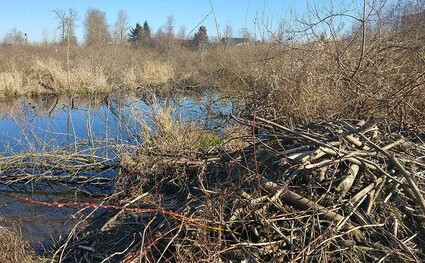Humility in nature
Last updated 6/9/2020 at Noon
The City of Fairview spent $2.4 million turning 13 acres of land into a Water Quality Facility. The plan was to create a simple and elegant system to filter and clean stormwater for 965 acres of industrial neighborhood, and what they pulled off was a wonderfully complex system of narrow, winding canals that looped back and forth and drained slowly through tiny barriers into one another, cleverly mimicking natural filtration systems found in wetlands. The city was thrilled. This facility was a masterpiece of human engineering. At last, man had mitigated his effect on nature by mimicking nature.
Then the beavers moved into the facility.
A family of beavers arrived all at once in the dead of night and began constructing dams. The water stopped flowing through the barriers altogether, and it stopped meandering back and forth through the narrow canals. It began pooling and changing the landscape.
Facility maintenance workers got busy removing the dams hoping the beavers would move along. The beavers did anything but move along and began rebuilding with what seemed like twice the resolve.
To justify more drastic measures, the city needed to prove that the beavers were harming the water quality (E. Coli sprang to everyone’s mind), but what they found was far less damning. The beavers were treating the water. Studies showed the dams were filtering twice as much mercury, copper, lead, zinc and pesticides than the human constructed filtration system. Further study revealed that the water temperature was cooler and suitable once again for long absent salmonids.
The beaver (Castor canadensis) is the largest rodent in North America and is easily recognized by its aquatic lifestyle, disproportionately large, orange incisors, and broad, flat waffle-iron tail. He can voluntarily seal his nostrils and ears shut and slide a transparent membrane over his eyes rendering himself a plush, airtight submarine.
The beauty of the beaver is its precise dam construction: beavers take such care in their repairs and maintenance that water passage through the dam is slowed to a mere trickle. And that water is filtered through rich, peaty soils, the leaflets of aspen bark, the gummed-up foliage of native shrubs and the fibrous heartwoods of local pine ultimately rendering it pure and clean. And, to keep the pressure of water from crumbling the dam, beavers see to it that somehow the water filters through many different levels in accordance with the flow of the original stream. Mild flows can be stemmed with straight dams and heavy flows with curved dams.
Humility is always forcibly earned, but never more so in nature. All the efforts of civil engineers and understanding of ecologists is severed with the gnawing of a few beaver teeth. I might have argued that it would have been more effective to cash 2.4 million in single bills and have the beavers use it to pack mud between the willow branches.
When I was 15 and working at a camp in Corbett, we used to while away our bright summer evenings with a game we called “canoe wrestling.” Two competitors would sit inside an aluminum canoe and push off from the dock into the network of shallow ponds that were there only by the productivity of beavers. The goal was simply to stand and throw the other girl out of the canoe while you remain inside. I was magnificently sturdy due to my disproportionately stout legs and I had yet to be matched.
Then one evening my successor came. She was a skinny and quiet girl. We pushed off from the dock and drifted into the deeper waters. The other girls watched from the shore and began to cheer and chant, some for and some against me. We stood, took a moment to adjust our footing, wide in a deep squat. I thought I would sink her easily. But no sooner had our hands clasped than I could feel my face hit the water and my shin scrape along the aluminum edge of the canoe. It was over.
I hung there for a moment, suspended in cold green water, humiliated. I opened my eyes. The stagnant water stung and clouded my vision. I saw a shadow float past me. Its smooth back shone murky gray streaks of light from the surface before it disappeared between sunken logs. I came up to the surface.
“Guys! I saw a beaver!”
Skepticism was the reply. I was accused of inventing means to distract from my failure.
So, I often think how large aquatic rodents don’t discern between humbling civil engineers and humbling self-conscious teenage girls. Had the beaver surfaced when I wanted him to or moved along when he was unwanted, there would be no great cause to sit quietly in awe of nature, to respect her ecology, and to stem the tide of human endeavors.

















Reader Comments(0)